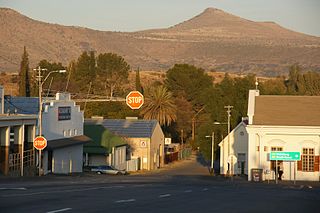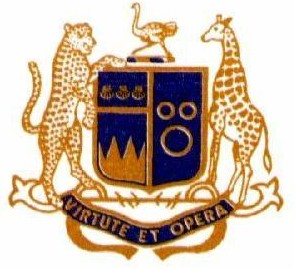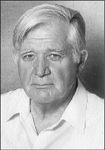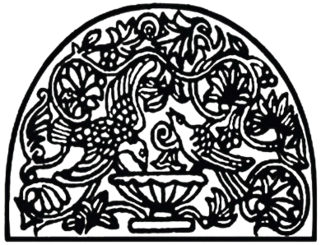
The Eastern Cape is one of the provinces of South Africa. Its capital is Bhisho, but its two largest cities are East London and Port Elizabeth.

Grahamstown is a town of about 140,000 people in the Eastern Cape province of South Africa. It is situated about 110 kilometres (70 mi) northeast of Port Elizabeth and 130 kilometres (80 mi) southwest of East London. It is the largest town in the Makana Local Municipality, and the seat of the municipal council. It also hosts Rhodes University, the Eastern Cape Division of the High Court, the South African Library for the Blind (SALB), a diocese of the Anglican Church of Southern Africa, and 6 South African Infantry Battalion. Furthermore, located approximately 3 km south-east of the town lies the world renowned Waterloo Farm, the only estuarine fossil site in the world from 360 million years ago with exceptional soft-tissue preservation.

The Royal Library of the Netherlands is the national library of the Netherlands, based in The Hague, founded in 1798. The KB collects everything that is published in and concerning the Netherlands, from medieval literature to today's publications. About 7 million publications are stored in the stockrooms, including books, newspapers, magazines and maps. The KB also offers many digital services, such as the national online Library, Delpher and The Memory. Since 2015, the KB has played a coordinating role for the network of the public library. The KB's collection of websites as hosted by the former Dutch internet provider XS4ALL is on the Unesco documentary world heritage memory of the world. It is the first web collection in the world that has been granted this status.

Cradock is a town in the Eastern Cape Province of South Africa, in the upper valley of the Great Fish River, 250 kilometres (160 mi) by road northeast of Port Elizabeth. The town is the administrative seat of the Inxuba Yethemba Local Municipality in the Chris Hani District of the Eastern Cape.
The National Arts Festival (NAF) is an annual festival of performing arts in Grahamstown, South Africa. It is the largest arts festival on the African continent and one of the largest performing arts festivals in the world by visitor numbers.

Graeme College is a public English medium high school for boys located in Makhanda (Grahamstown) in the Eastern Cape province of South Africa. It caters for boys from Grade 00 to Grade 12 and offers both boarding and day options to its pupils. It was founded in April 1873.

Frederick Guy Butler was a South African poet, academic and writer.

Olive Schreiner was a South African author, anti-war campaigner and intellectual. She is best remembered today for her novel The Story of an African Farm (1883), which has been highly acclaimed. It deals boldly with such contemporary issues as agnosticism, existential independence, individualism, the professional aspirations of women, and the elemental nature of life on the colonial frontier.

The 1820 Settlers National Monument, which honours the contribution to South African society made by the British 1820 Settlers, overlooks Makhanda in the Eastern Cape. It commemorates the Anglo-Africans, as well as the English language, as much as the settlers themselves. The building was designed by John Sturrock, Sturrock was inspired by the work of Louis Kahn.
Marguerite Poland is a South African writer and author of eleven children's books.
Peter Clarke was a South African visual artist working across a broad spectrum of media. He was also a writer and poet.

Smithsonian Libraries and Archives is an institutional archives and library system comprising 21 branch libraries serving the various Smithsonian Institution museums and research centers. The Libraries and Archives serve Smithsonian Institution staff as well as the scholarly community and general public with information and reference support. Its collections number nearly 3 million volumes including 50,000 rare books and manuscripts.

Makhanda, also spelled Makana and also known as Nxele, was a Xhosa indigenous doctor. He served as a top advisor to Chief Ndlambe. During the Xhosa Wars, on the 22nd of April, 1819, he initiated an abortive assault on the town of Grahamstown, in what was then the Cape Colony.
Beth Diane Armstrong is a South African sculptor. Her skills, ambitious scale and large projects have allowed her to assume the role and position alongside many of her South African male counterparts. For the last number of years she has worked predominantly on monumental artworks made of mild and stainless steel but there are a variety of different materials to her repertoire: other sculpting media as well as printmaking, video, photography, drawing and installations.
Christopher Michael Zithulele Mann(1948 – 10 March 2021) was a South African poet.
The Rhodes University Library is a library located in Makhanda, under the Makana municipality. It was initially established in 1937 in the Clock Tower building of Rhodes University College.

Senzeni Marasela is a South African visual artist born in Thokoza who works across different media, combining performance, photography, video, prints, textiles and embroidery in mixed-medium installations. She obtained a BA in Fine Arts at the Wits School of Arts, University of the Witwatersrand, Johannesburg in 1998. Her work is exhibited in South Africa, Europe and the United States, and part of local and international collections, including Museum of Modern Art or the Newark Museum and is referenced in numerous academic papers, theses journal and book publications.
Mmakgabo Mmapula Mmangankato Helen Sebidi is a South African artist born in Marapyane (Skilpadfontein) near Hamanskraal, Pretoria who lives and works in Johannesburg. Sebidi's work has been represented in private and public collections, including at the National Museum of Women in the Arts, Washington and New York the Smithsonian National Museum of African Art, New York, and the World Bank. Her work has been recognised internationally and locally. In 1989 she won the Standard Bank Young Artist award, becoming the first black woman to win the award. In 2004, President Thabo Mbeki awarded her the Order of Ikhamanga in Silver – which is the highest honor given to those considered a "national treasure". In 2011, she was awarded the Arts and Culture Trust (ACT) Lifetime Achievement Award for Visual Art, whilst in 2015 she received the Mbokodo Award. In September 2018, Sebidi was honoured with one of the first solo presentations at the Norval Foundation in Cape Town – a retrospective entitled Batlhaping Ba Re.
Gerald Machona is a Zimbabwean Visual contemporary artist .The most recognizable aspect of his work is his use of decommissioned Zimbabwean dollars. Machona works in sculpture, performance, new media, photography and film. In Machona's work, he explores issues of migration, transnationality, social interaction and xenophobia in South Africa.

Museum of Literature and Theater Arts of Bosnia and Herzegovina is a literary art museum in Sarajevo, Bosnia and Herzegovina. It was established under the name Museum of Literature of Bosnia and Herzegovina in 1961 on the idea of then curator of literary collections in the Museum of Sarajevo, writer Razija Handžić, the future director. In 1970, the Theater Department was founded and added to the Museum of Literature.












